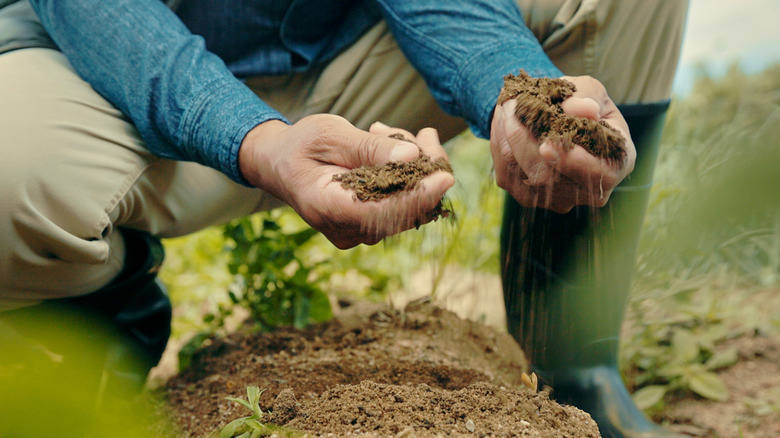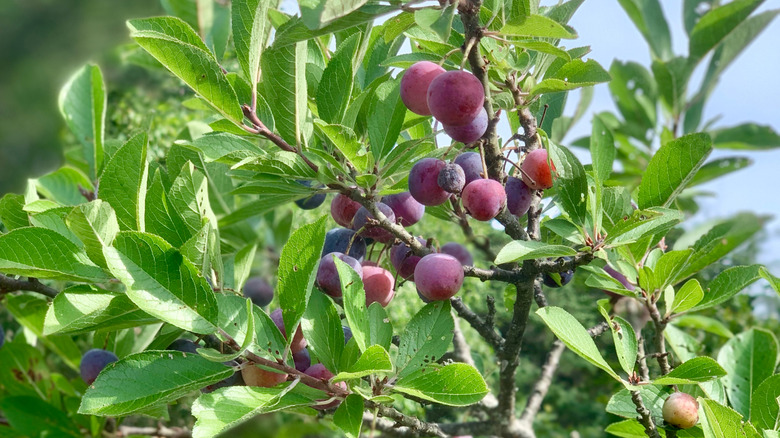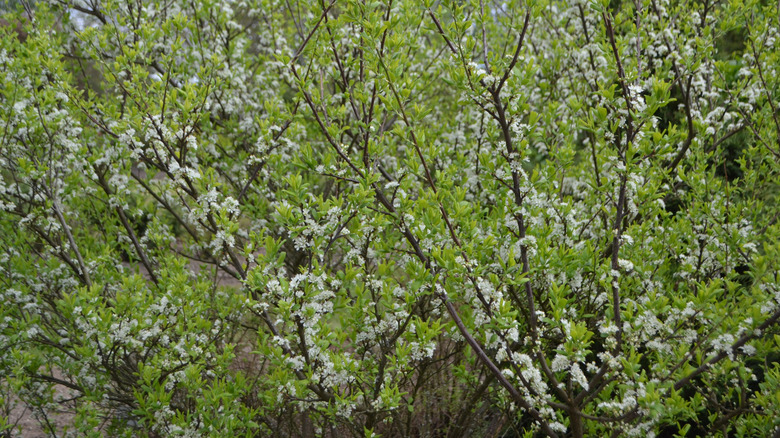The Tasty Fruit Tree You Can Grow In Sandy Soil Conditions
Planting a fruit tree can give you many benefits. Not only will you have some beautiful greenery, but you will also get the added advantages of shade and, of course, fruit. If you have sandy soil in your yard, though, you may be wondering which fruit trees are viable options. There are certainly some tropical fruit trees you will want to stay far away from, such as the poisonous manchineel. Luckily, there are a few great contenders, including the unique perennial beach plum tree (Prunus maritima), which could be the perfect choice for you to plant in your sandy soil.
The beach plum, also called the seaside plum, sand plum, or Graves' plum, is actually a woody shrub that produces small, tart plums which are often used to make jams and jellies. These plants can grow to be about 6 feet tall and 6 feet wide. Being native to the coastal mid-Atlantic and Northeast, they grow in sandy soil conditions, particularly in sand dunes along beaches, and they happen to be one of the 15 best native plants to grow if you live in New England.
Plus, for anyone who lives further inland, beach plum trees can still be a unique fruit tree option worth considering, as they can grow as well or even better in soil away from the coast. Before running out and finding a beach plum tree to plant, however, you should make sure it is suitable for your soil, determine how to best care for it, and learn about some potential drawbacks to having the plant in your yard.
How to grow and care for a beach plum tree
The ideal conditions for a beach plum tree include full sun and well-drained soil with a pH between 6 and 7, but you may want to consider adding more nutrients to the soil if your goal is for the tree to produce lots of high-quality fruit. Keeping in mind the potential size of the tree, beach plum trees should be planted about 10 feet apart for orchard purposes. For use in hedgerows, aim for a spacing of 3 to 5 feet. Also, if you're looking to grow some plums, keep in mind that beach plum plants are not self-fertile and require cross-pollination. This means you will need at least two clonal varieties of beach plum trees in order for them to produce fruit. Once you have your plan, learn how to successfully plant a tree in sandy soil with some helpful tips and get started.
The best way to plant beach plum is by using nursery-grown clonal material or propagation and grafting with existing rootstock. However, you can also start with a seed from the fruit. Remove the pit from the fruit and immediately plant the seed outdoors. You can plant in the ground in late fall or mix peat moss with the seed to plant in the spring. Seedlings can grow up to about 12 inches tall in just one year. With proper care and fertilization as needed, your plant will grow beautifully. For more mature plants, consider pruning in late winter and early spring. Early may is a good time to start weeding to remove competing plants and applying fertilizer if needed for the summer. Just do not over-fertilize. The fruit should be ready to harvest in late August.
What to consider before planting a beach plum
If you successfully plant and care for your tree, you will reap the shade, fruit, and aesthetic benefits. However, you should also be aware of some of the potential drawbacks related to beach plum trees. First, beach plum trees are susceptible to a number of diseases, such as brown rot, a fungal disease that is common in fruit trees and causes damage to the fruit and flowers of the tree. These plants may also be affected by black knot, a fungal disease that can cause tree limbs to die. While they may be susceptible to fungal diseases, luckily, beach plum trees do not typically have very many pests. Finally, be aware that beach plum trees are prone to suckering and will require maintenance to keep them in their desired shapes. If you make sure that your conditions are appropriate for this tree's needs and give it the proper care, however, then your tree should thrive for years to come.
Overall, if you have sandy soil that is not very nutrient-dense but want a fruit tree, then beach plum trees are an effective and relatively low-maintenance choice. They will grow well and produce a small grape-sized fruit that is tart but delicious and can be consumed immediately or turned into jams, jellies, desserts, and drinks. The flowers are lovely, and the purple-red color of the fruits is also gorgeous on the trees.


